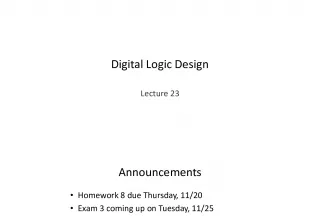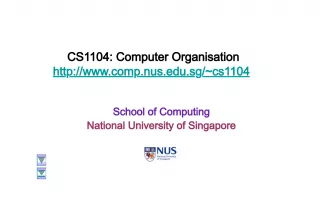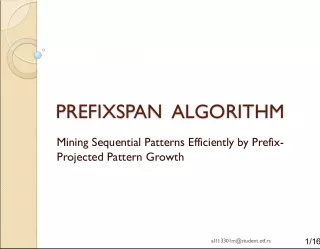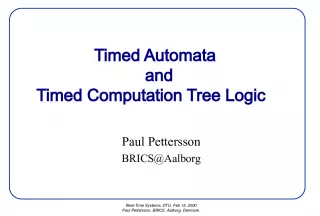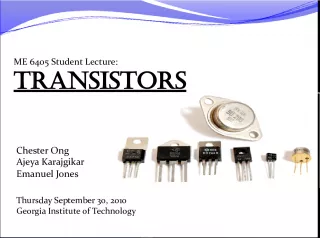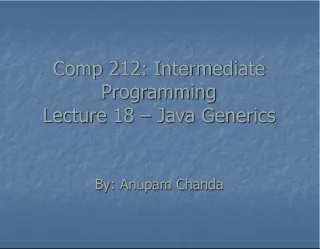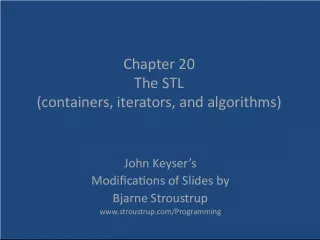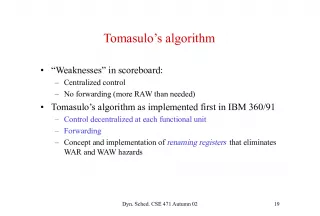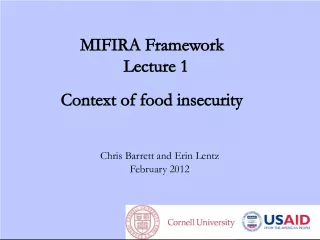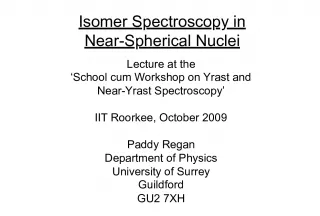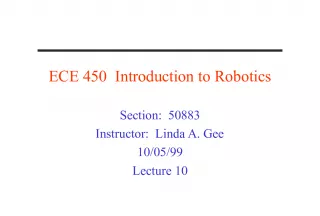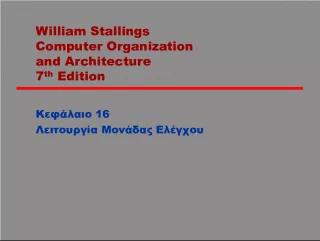CS1104 Lecture 13: Sequential Logic, Counters and Registers


This lecture covers topics related to sequential logic, including counters and registers. The lecture discusses the introduction of counters, asynchronous and synchronous counters, and designing synchronous counters.
- Uploaded on | 4 Views
-
 celeena
celeena
About CS1104 Lecture 13: Sequential Logic, Counters and Registers
PowerPoint presentation about 'CS1104 Lecture 13: Sequential Logic, Counters and Registers'. This presentation describes the topic on This lecture covers topics related to sequential logic, including counters and registers. The lecture discusses the introduction of counters, asynchronous and synchronous counters, and designing synchronous counters.. The key topics included in this slideshow are CS1104, computer organization, sequential logic, counters, registers,. Download this presentation absolutely free.
Presentation Transcript
1. CS1104 Computer Organization http://www.comp.nus.edu.sg/~cs1104 Aaron Tan Tuck Choy School of Computing National University of Singapore
2. CS1104-13 Lecture 13: Sequential Logic: Counters and Registers 2 Lecture 13: Sequential Logic Counters and Registers Counters Introduction: Counters Asynchronous (Ripple) Counters Asynchronous Counters with MOD number < 2 n Asynchronous Down Counters Cascading Asynchronous Counters
3. CS1104-13 Lecture 13: Sequential Logic: Counters and Registers 3 Lecture 13: Sequential Logic Counters and Registers Synchronous (Parallel) Counters Up/Down Synchronous Counters Designing Synchronous Counters Decoding A Counter Counters with Parallel Load
4. CS1104-13 Lecture 13: Sequential Logic: Counters and Registers 4 Lecture 13: Sequential Logic Counters and Registers Registers Introduction: Registers Simple Registers Registers with Parallel Load Using Registers to implement Sequential Circuits Shift Registers Serial In/Serial Out Shift Registers Serial In/Parallel Out Shift Registers Parallel In/Serial Out Shift Registers Parallel In/Parallel Out Shift Registers
5. CS1104-13 Lecture 13: Sequential Logic: Counters and Registers 5 Lecture 13: Sequential Logic Counters and Registers Bidirectional Shift Registers An Application Serial Addition Shift Register Counters Ring Counters Johnson Counters Random-Access Memory (RAM)
6. CS1104-13 Introduction: Counters 6 Introduction: Counters Counters are circuits that cycle through a specified number of states. Two types of counters: synchronous (parallel) counters asynchronous (ripple) counters Ripple counters allow some flip-flop outputs to be used as a source of clock for other flip-flops. Synchronous counters apply the same clock to all flip-flops.
7. CS1104-13 Asynchronous (Ripple) Counters 7 Asynchronous (Ripple) Counters Asynchronous counters : the flip-flops do not change states at exactly the same time as they do not have a common clock pulse. Also known as ripple counters , as the input clock pulse ripples through the counter cumulative delay is a drawback. n flip-flops a MOD (modulus) 2 n counter. (Note: A MOD- x counter cycles through x states.) Output of the last flip-flop (MSB) divides the input clock frequency by the MOD number of the counter, hence a counter is also a frequency divider .
8. CS1104-13 Asynchronous (Ripple) Counters 8 Asynchronous (Ripple) Counters Example: 2-bit ripple binary counter. Output of one flip-flop is connected to the clock input of the next more-significant flip-flop. K J K J HIGH Q 0 Q 1 Q 0 FF1 FF0 CLK C C Timing diagram 00 01 10 11 00 ... 4 3 2 1 CLK Q 0 Q 0 Q 1 1 1 1 1 0 0 0 0 0 0
9. CS1104-13 Asynchronous (Ripple) Counters 9 Asynchronous (Ripple) Counters Example: 3-bit ripple binary counter. K J K J Q 0 Q 1 Q 0 FF1 FF0 C C K J Q 1 C FF2 Q 2 CLK HIGH
10. CS1104-13 Asynchronous (Ripple) Counters 10 Asynchronous (Ripple) Counters Propagation delays in an asynchronous (ripple- clocked) binary counter. If the accumulated delay is greater than the clock pulse, some counter states may be misrepresented! 4 3 2 1 CLK Q 0 Q 1 Q 2 t PLH (CLK to Q 0 ) t PHL (CLK to Q 0 ) t PLH ( Q 0 to Q 1 ) t PHL (CLK to Q 0 ) t PHL ( Q 0 to Q 1 ) t PLH ( Q 1 to Q 2 )
11. CS1104-13 Asynchronous (Ripple) Counters 11 Asynchronous (Ripple) Counters Example: 4-bit ripple binary counter (negative-edge triggered). K J K J Q 1 Q 0 FF1 FF0 C C K J C FF2 Q 2 CLK HIGH K J C FF3 Q 3
12. CS1104-13 Asynchronous Counters with MOD number < 2^n 12 Asyn. Counters with MOD no. < 2 n States may be skipped resulting in a truncated sequence . Technique: force counter to recycle before going through all of the states in the binary sequence. Example: Given the following circuit, determine the counting sequence (and hence the modulus no.) K J Q Q CLK CLR K J Q Q CLK CLR K J Q Q CLK CLR C B A B C All J , K inputs are 1 (HIGH).
13. CS1104-13 Asynchronous Counters with MOD number < 2^n 13 Asyn. Counters with MOD no. < 2 n Example (contd): K J Q Q CLK CLR K J Q Q CLK CLR K J Q Q CLK CLR C B A B C All J , K inputs are 1 (HIGH). MOD-6 counter produced by clearing (a MOD-8 binary counter) when count of six (110) occurs.
14. CS1104-13 Asynchronous Counters with MOD number < 2^n 14 Asyn. Counters with MOD no. < 2 n Example (contd): Counting sequence of circuit (in CBA order). 111 000 001 110 101 100 010 011 Temporary state Counter is a MOD-6 counter . 0 0 0 1 0 0 0 1 0 1 1 0 0 0 1 1 0 1 0 0 0 1 0 0
15. CS1104-13 Asynchronous Counters with MOD number < 2^n 15 Asyn. Counters with MOD no. < 2 n Exercise: How to construct an asynchronous MOD-5 counter? MOD-7 counter? MOD-12 counter? Question: The following is a MOD-? counter? K J Q Q CLR C B A C D E F All J = K = 1 . K J Q Q CLR K J Q Q CLR K J Q Q CLR K J Q Q CLR K J Q Q CLR D E F
16. CS1104-13 Asynchronous Counters with MOD number < 2^n 16 Asyn. Counters with MOD no. < 2 n Decade counters (or BCD counters ) are counters with 10 states (modulus-10) in their sequence. They are commonly used in daily life (e.g.: utility meters, odometers, etc.). Design an asynchronous decade counter. D CLK HIGH K J C CLR Q K J C CLR Q C K J C CLR Q B K J C CLR Q A ( A.C ) '
17. CS1104-13 Asynchronous Counters with MOD number < 2^n 17 Asyn. Counters with MOD no. < 2 n Asynchronous decade/BCD counter (contd). D CLK HIGH K J C CLR Q K J C CLR Q C K J C CLR Q B K J C CLR Q A ( A.C ) ' 0 0 0 0 1 0 0 0 0 1 0 0 1 1 0 0 0 0 1 0 1 0 1 0 0 1 1 0 1 1 1 0 0 0 0 1 1 0 0 1 0 0 0 0
18. CS1104-13 Asynchronous Down Counters 18 Asynchronous Down Counters So far we are dealing with up counters . Down counters , on the other hand, count downward from a maximum value to zero, and repeat. Example: A 3-bit binary (MOD-2 3 ) down counter. K J K J Q 1 Q 0 C C K J C Q 2 CLK 1 Q Q' Q Q' Q Q' Q Q' 3-bit binary up counter 3-bit binary down counter 1 K J K J Q 1 Q 0 C C K J C Q 2 CLK Q Q' Q Q' Q Q' Q Q'
19. CS1104-13 Asynchronous Down Counters 19 Asynchronous Down Counters Example: A 3-bit binary (MOD-8) down counter. 001 000 111 010 011 100 110 101 1 K J K J Q 1 Q 0 C C K J C Q 2 CLK Q Q' Q Q' Q Q' Q Q'
20. CS1104-13 Cascading Asynchronous Counters 20 Cascading Asynchronous Counters Larger asynchronous (ripple) counter can be constructed by cascading smaller ripple counters. Connect last-stage output of one counter to the clock input of next counter so as to achieve higher- modulus operation. Example: A modulus-32 ripple counter constructed from a modulus-4 counter and a modulus-8 counter. K J K J Q 1 Q 0 C C CLK Q Q' Q Q' Q Q' K J K J Q 3 Q 2 C C K J C Q 4 Q Q' Q Q' Q Q' Q Q' Modulus-4 counter Modulus-8 counter
21. CS1104-13 Cascading Asynchronous Counters 21 Cascading Asynchronous Counters Example: A 6-bit binary counter (counts from 0 to 63) constructed from two 3-bit counters. 3-bit binary counter 3-bit binary counter Count pulse A 0 A 1 A 2 A 3 A 4 A 5
22. CS1104-13 Cascading Asynchronous Counters 22 Cascading Asynchronous Counters If counter is a not a binary counter, requires additional output. Example: A modulus-100 counter using two decade counters. CLK Decade counter Q 3 Q 2 Q 1 Q 0 C CTEN TC 1 Decade counter Q 3 Q 2 Q 1 Q 0 C CTEN TC freq freq /10 freq /100 TC = 1 when counter recycles to 0000
23. CS1104-13 Synchronous (Parallel) Counters 23 Synchronous (Parallel) Counters Synchronous (parallel) counters : the flip-flops are clocked at the same time by a common clock pulse. We can design these counters using the sequential logic design process (covered in Lecture #12). Example: 2-bit synchronous binary counter (using T flip-flops, or JK flip-flops with identical J,K inputs). 01 00 10 11
24. CS1104-13 Synchronous (Parallel) Counters 24 Synchronous (Parallel) Counters Example: 2-bit synchronous binary counter (using T flip-flops, or JK flip-flops with identical J,K inputs). TA 1 = A 0 TA 0 = 1 1 K J K J A 1 A 0 C C CLK Q Q' Q Q' Q Q'
25. CS1104-13 Synchronous (Parallel) Counters 25 Synchronous (Parallel) Counters Example: 3-bit synchronous binary counter (using T flip-flops, or JK flip-flops with identical J, K inputs). TA 2 = A 1 .A 0 A 2 A 1 A 0 1 1 TA 1 = A 0 TA 0 = 1 A 2 A 1 A 0 1 1 1 1 A 2 A 1 A 0 1 1 1 1 1 1 1 1
26. CS1104-13 Synchronous (Parallel) Counters 26 Synchronous (Parallel) Counters Example: 3-bit synchronous binary counter (contd). TA 2 = A 1 .A 0 TA 1 = A 0 TA 0 = 1 1 A 2 CP A 1 A 0 K Q J K Q J K Q J
27. CS1104-13 Synchronous (Parallel) Counters 27 Synchronous (Parallel) Counters Note that in a binary counter, the n th bit (shown underlined) is always complemented whenever 0 1111 1 0000 or 1 1111 0 0000 Hence, X n is complemented whenever X n-1 X n-2 ... X 1 X 0 = 1111. As a result, if T flip-flops are used, then TX n = X n-1 . X n-2 . ... . X 1 . X 0
28. CS1104-13 Synchronous (Parallel) Counters 28 Synchronous (Parallel) Counters Example: 4-bit synchronous binary counter. TA 3 = A 2 . A 1 . A 0 TA 2 = A 1 . A 0 TA 1 = A 0 TA 0 = 1 1 K J K J A 1 A 0 C C CLK Q Q' Q Q' Q Q' K J A 2 C Q Q' K J A 3 C Q Q' A 1 .A 0 A 2 .A 1 .A 0
29. CS1104-13 Synchronous (Parallel) Counters 29 Synchronous (Parallel) Counters Example: Synchronous decade/BCD counter. T 0 = 1 T 1 = Q 3 ' . Q 0 T 2 = Q 1 . Q 0 T 3 = Q 2 . Q 1 . Q 0 + Q 3 . Q 0
30. CS1104-13 Synchronous (Parallel) Counters 30 Synchronous (Parallel) Counters Example: Synchronous decade/BCD counter (contd). T 0 = 1 T 1 = Q 3 ' . Q 0 T 2 = Q 1 . Q 0 T 3 = Q 2 . Q 1 . Q 0 + Q 3 . Q 0 1 Q 1 Q 0 CLK T C Q Q' Q Q' Q 2 Q 3 T C Q Q' Q Q' T C Q Q' Q Q' T C Q Q' Q Q'
31. CS1104-13 Up/Down Synchronous Counters 31 Up/Down Synchronous Counters Up/down synchronous counter : a bidirectional counter that is capable of counting either up or down. An input (control) line Up / Down (or simply Up ) specifies the direction of counting. Up / Down = 1 Count upward Up / Down = 0 Count downward
32. CS1104-13 Up/Down Synchronous Counters 32 Up/Down Synchronous Counters Example: A 3-bit up/down synchronous binary counter. TQ 0 = 1 TQ 1 = ( Q 0 . Up ) + ( Q 0 ' . Up' ) TQ 2 = ( Q 0 . Q 1 . Up ) + ( Q 0 ' . Q 1 ' . Up' ) Up counter TQ 0 = 1 TQ 1 = Q 0 TQ 2 = Q 0 . Q 1 Down counter TQ 0 = 1 TQ 1 = Q 0 TQ 2 = Q 0 . Q 1
33. CS1104-13 Up/Down Synchronous Counters 33 Up/Down Synchronous Counters Example: A 3-bit up/down synchronous binary counter (contd). TQ 0 = 1 TQ 1 = ( Q 0 . Up ) + ( Q 0 ' . Up' ) TQ 2 = ( Q 0 . Q 1 . Up ) + ( Q 0 ' . Q 1 ' . Up' ) 1 Q 1 Q 0 CLK T C Q Q' Q Q' T C Q Q' Q Q' T C Q Q' Q Q' Up Q 2
34. CS1104-13 Designing Synchronous Counters 34 Designing Synchronous Counters Covered in Lecture #12. Example: A 3-bit Gray code counter (using JK flip-flops). 100 000 001 101 111 110 011 010
35. CS1104-13 Designing Synchronous Counters 35 Designing Synchronous Counters 3-bit Gray code counter: flip-flop inputs. 0 1 00 01 11 10 Q 2 Q 1 Q 0 X X X X 1 JQ 2 = Q 1 .Q 0 ' 0 1 00 01 11 10 Q 2 Q 1 Q 0 X X X X 1 KQ 2 = Q 1 '.Q 0 ' 0 1 00 01 11 10 Q 2 Q 1 Q 0 X X X X 1 JQ 1 = Q 2 '.Q 0 0 1 00 01 11 10 Q 2 Q 1 Q 0 X X X X 1 KQ 1 = Q 2 .Q 0 0 1 00 01 11 10 Q 2 Q 1 Q 0 X X X X 1 JQ 0 = Q 2 .Q 1 + Q 2 '.Q 1 ' = ( Q 2 Q 1 )' 1 0 1 00 01 11 10 Q 2 Q 1 Q 0 X X X X 1 1 KQ 0 = Q 2 .Q 1 ' + Q 2 '.Q 1 = Q 2 Q 1
36. CS1104-13 Designing Synchronous Counters 36 Designing Synchronous Counters 3-bit Gray code counter: logic diagram. JQ 2 = Q 1 .Q 0 ' JQ 1 = Q 2 '.Q 0 JQ 0 = ( Q 2 Q 1 )' KQ 2 = Q 1 '.Q 0 ' KQ 1 = Q 2 .Q 0 KQ 0 = Q 2 Q 1 Q 1 Q 0 CLK Q 2 J C Q Q' K J C Q Q' K J C Q Q' K Q 2 ' Q 0 ' Q 1 '
37. CS1104-13 Decoding A Counter 37 Decoding A Counter Decoding a counter involves determining which state in the sequence the counter is in. Differentiate between active-HIGH and active-LOW decoding. Active-HIGH decoding: output HIGH if the counter is in the state concerned. Active-LOW decoding: output LOW if the counter is in the state concerned.
38. CS1104-13 Decoding A Counter 38 Decoding A Counter Example: MOD-8 ripple counter (active-HIGH decoding). A' B' C' 1 2 3 4 5 6 7 8 9 Clock HIGH only on count of ABC = 000 A' B' C HIGH only on count of ABC = 001 A' B C' HIGH only on count of ABC = 010 10 0 A B C HIGH only on count of ABC = 111 . . .
39. CS1104-13 Decoding A Counter 39 Decoding A Counter Example: To detect that a MOD-8 counter is in state 0 (000) or state 1 (001). A' B' 1 2 3 4 5 6 7 8 9 Clock HIGH only on count of ABC = 000 or ABC = 001 10 0 Example: To detect that a MOD-8 counter is in the odd states (states 1, 3, 5 or 7), simply use C . C 1 2 3 4 5 6 7 8 9 Clock HIGH only on count of odd states 10 0 A' B' C' A' B' C
40. CS1104-13 Counters with Parallel Load 40 Counters with Parallel Load Counters could be augmented with parallel load capability for the following purposes: To start at a different state To count a different sequence As more sophisticated register with increment/decrement functionality.
41. CS1104-13 Counters with Parallel Load 41 Counters with Parallel Load Different ways of getting a MOD-6 counter: Count = 1 Load = 0 CP I 4 I 3 I 2 I 1 Count = 1 Clear = 1 CP A 4 A 3 A 2 A 1 Inputs = 0 Load (a) Binary states 0,1,2,3,4,5. I 4 I 3 I 2 I 1 A 4 A 3 A 2 A 1 Inputs have no effect Clear (b) Binary states 0,1,2,3,4,5. I 4 I 3 I 2 I 1 Count = 1 Clear = 1 CP A 4 A 3 A 2 A 1 0 0 1 1 Load (d) Binary states 3,4,5,6,7,8. I 4 I 3 I 2 I 1 Count = 1 Clear = 1 CP A 4 A 3 A 2 A 1 1 0 1 0 Load Carry-out (c) Binary states 10,11,12,13,14,15.
42. CS1104-13 Counters with Parallel Load 42 Counters with Parallel Load 4-bit counter with parallel load.
43. CS1104-13 Introduction: Registers 43 Introduction: Registers An n -bit register has a group of n flip-flops and some logic gates and is capable of storing n bits of information. The flip-flops store the information while the gates control when and how new information is transferred into the register. Some functions of register: retrieve data from register store/load new data into register (serial or parallel) shift the data within register (left or right)
44. CS1104-13 Simple Registers 44 Simple Registers No external gates. Example: A 4-bit register. A new 4-bit data is loaded every clock cycle. A 3 CP A 1 A 0 D Q D Q Q D A 2 D Q I 3 I 1 I 0 I 2
45. CS1104-13 Registers With Parallel Load 45 Registers With Parallel Load Instead of loading the register at every clock pulse, we may want to control when to load. Loading a register: transfer new information into the register. Requires a load control input. Parallel loading : all bits are loaded simultaneously.
46. CS1104-13 Registers With Parallel Load 46 Registers With Parallel Load Load' . A 0 + Load . I 0
47. CS1104-13 Using Registers to implement Sequential Circuits 47 Using Registers to implement Sequential Circuits A sequential circuit may consist of a register (memory) and a combinational circuit . Register Combin- ational circuit Clock Inputs Outputs Next-state value The external inputs and present states of the register determine the next states of the register and the external outputs, through the combinational circuit. The combinational circuit may be implemented by any of the methods covered in MSI components and Programmable Logic Devices .
48. CS1104-13 Using Registers to implement Sequential Circuits 48 Using Registers to implement Sequential Circuits Example 1: A 1 + = m(4,6) = A 1 . x' A 2 + = m(1,2,5,6) = A 2 . x' + A 2 ' . x = A 2 x y = m(3,7) = A 2 . x A 1 A 2 x y A 1 . x' A 2 x
49. CS1104-13 Using Registers to implement Sequential Circuits 49 Using Registers to implement Sequential Circuits Example 2: Repeat example 1, but use a ROM. ROM truth table A 1 A 2 x y 8 x 3 ROM
50. CS1104-13 Shift Registers 50 Shift Registers Another function of a register, besides storage, is to provide for data movements . Each stage (flip-flop) in a shift register represents one bit of storage, and the shifting capability of a register permits the movement of data from stage to stage within the register, or into or out of the register upon application of clock pulses.
51. CS1104-13 Shift Registers 51 Shift Registers Basic data movement in shift registers (four bits are used for illustration). Data in Data out (a) Serial in/shift right/serial out Data in Data out (b) Serial in/shift left/serial out Data in Data out (c) Parallel in/serial out Data out Data in (d) Serial in/parallel out Data out Data in (e) Parallel in / parallel out (f) Rotate right (g) Rotate left
52. CS1104-13 Serial In/Serial Out Shift Registers 52 Serial In/Serial Out Shift Registers Accepts data serially one bit at a time and also produces output serially. Q 0 CLK D C Q Q 1 Q 2 Q 3 Serial data input Serial data output D C Q D C Q D C Q
53. CS1104-13 Serial In/Serial Out Shift Registers 53 Serial In/Serial Out Shift Registers Application: Serial transfer of data from one register to another. Shift register A Shift register B SI SI SO SO Clock Shift control CP Wordtime T 1 T 2 T 3 T 4 CP Clock Shift control
54. CS1104-13 Serial In/Serial Out Shift Registers 54 Serial In/Serial Out Shift Registers Serial-transfer example.
55. CS1104-13 Serial In/Parallel Out Shift Registers 55 Serial In/Parallel Out Shift Registers Accepts data serially. Outputs of all stages are available simultaneously. Q 0 CLK D C Q Q 1 D C Q Q 2 D C Q Q 3 D C Q Data input D C CLK Data input Q 0 Q 1 Q 2 Q 3 SRG 4 Logic symbol
56. CS1104-13 Parallel In/Serial Out Shift Registers 56 Parallel In/Serial Out Shift Registers Bits are entered simultaneously, but output is serial. D 0 CLK D C Q D 1 D C Q D 2 D C Q D 3 D C Q Data input Q 0 Q 1 Q 2 Q 3 Serial data out SHIFT / LOAD SHIFT . Q 0 + SHIFT' . D 1
57. CS1104-13 Parallel In/Serial Out Shift Registers 57 Parallel In/Serial Out Shift Registers Bits are entered simultaneously, but output is serial. Logic symbol C CLK SHIFT / LOAD D 0 D 1 D 2 D 3 SRG 4 Serial data out Data in
58. CS1104-13 Parallel In/Parallel Out Shift Registers 58 Parallel In/Parallel Out Shift Registers Simultaneous input and output of all data bits. Q 0 CLK D C Q Q 1 D C Q Q 2 D C Q Q 3 D C Q Parallel data inputs D 0 D 1 D 2 D 3 Parallel data outputs
59. CS1104-13 Bidirectional Shift Registers 59 Bidirectional Shift Registers Data can be shifted either left or right, using a control line RIGHT / LEFT (or simply RIGHT ) to indicate the direction. RIGHT . Q 0 + RIGHT' . Q 2
60. CS1104-13 Bidirectional Shift Registers 60 Bidirectional Shift Registers 4-bit bidirectional shift register with parallel load.
61. CS1104-13 Bidirectional Shift Registers 61 Bidirectional Shift Registers 4-bit bidirectional shift register with parallel load.
62. CS1104-13 An Application Serial Addition 62 An Application Serial Addition Most operations in digital computers are done in parallel. Serial operations are slower but require less equipment. A serial adder is shown below. A A + B . FA x y z S C Shift-register A Shift-right CP SI Shift-register B SI External input SO SO Q D Clear
63. CS1104-13 An Application Serial Addition 63 An Application Serial Addition A = 0100; B = 0111. A + B = 1011 is stored in A after 4 clock pulses. Initial: A : 0 1 0 0 B : 0 1 1 1 Q : 0 Step 1: 0 + 1 + 0 S = 1 , C = 0 A : 1 0 1 0 B : x 0 1 1 Q : 0 Step 2: 0 + 1 + 0 S = 1 , C = 0 A : 1 1 0 1 B : x x 0 1 Q : 0 Step 3: 1 + 1 + 0 S = 0 , C = 1 A : 0 1 1 0 B : x x x 0 Q : 1 Step 4: 0 + 0 + 1 S = 1 , C = 0 A : 1 0 1 1 B : x x x x Q : 0
64. CS1104-13 Shift Register Counters 64 Shift Register Counters Shift register counter : a shift register with the serial output connected back to the serial input. They are classified as counters because they give a specified sequence of states. Two common types: the Johnson counter and the Ring counter .
65. CS1104-13 Ring Counters 65 Ring Counters One flip-flop (stage) for each state in the sequence. The output of the last stage is connected to the D input of the first stage. An n -bit ring counter cycles through n states. No decoding gates are required, as there is an output that corresponds to every state the counter is in.
66. CS1104-13 Ring Counters 66 Ring Counters Example: A 6-bit (MOD-6) ring counter. CLK Q 0 D Q D Q D Q D Q D Q D Q Q 1 Q 2 Q 3 Q 4 Q 5 CLR PRE 100000 010000 001000 000100 000010 000001
67. CS1104-13 Johnson Counters 67 Johnson Counters The complement of the output of the last stage is connected back to the D input of the first stage. Also called the twisted-ring counter . Require fewer flip-flops than ring counters but more flip-flops than binary counters. An n -bit Johnson counter cycles through 2 n states. Require more decoding circuitry than ring counter but less than binary counters.
68. CS1104-13 Johnson Counters 68 Johnson Counters Example: A 4-bit (MOD-8) Johnson counter. CLK Q 0 D Q D Q D Q D Q Q 1 Q 2 Q 3 ' CLR Q' 0000 0001 0011 0111 1111 1110 1100 1000
69. CS1104-13 Johnson Counters 69 Johnson Counters Decoding logic for a 4-bit Johnson counter. A' D' State 0 A D State 4 B C' State 2 C D' State 3 A B' State 1 A' B State 5 B' C State 6 C' D State 7
70. CS1104-13 Random Access Memory (RAM) 70 Random Access Memory (RAM) A memory unit stores binary information in groups of bits called words . The data consists of n lines (for n -bit words). Data input lines provide the information to be stored ( written ) into the memory, while data output lines carry the information out ( read ) from the memory. The address consists of k lines which specify which word (among the 2 k words available) to be selected for reading or writing. The control lines Read and Write (usually combined into a single control line Read/Write ) specifies the direction of transfer of the data.
71. CS1104-13 Random Access Memory (RAM) 71 Random Access Memory (RAM) Block diagram of a memory unit: Memory unit 2 k words n bits per word k address lines k Read / Write n n n data input lines n data output lines
72. CS1104-13 Random Access Memory (RAM) 72 Random Access Memory (RAM) Content of a 1024 x 16-bit memory: 1011010111011101 1010000110000110 0010011101110001 : : 1110010101010010 0011111010101110 1011000110010101 Memory content decimal 0 1 2 : : 1021 1022 1023 0000000000 0000000001 0000000010 : : 1111111101 1111111110 1111111111 binary Memory address
73. CS1104-13 Random Access Memory (RAM) 73 Random Access Memory (RAM) The Write operation: Transfers the address of the desired word to the address lines Transfers the data bits (the word) to be stored in memory to the data input lines Activates the Write control line (set Read / Write to 0) The Read operation: Transfers the address of the desired word to the address lines Activates the Read control line (set Read / Write to 1)
74. CS1104-13 Random Access Memory (RAM) 74 Random Access Memory (RAM) The Read/Write operation: Two types of RAM: Static and dynamic. Static RAMs use flip-flops as the memory cells. Dynamic RAMs use capacitor charges to represent data. Though simpler in circuitry, they have to be constantly refreshed.
75. CS1104-13 Random Access Memory (RAM) 75 Random Access Memory (RAM) A single memory cell of the static RAM has the following logic and block diagrams. R S Q Input Select Output Read/Write BC Output Input Select Read/Write Logic diagram Block diagram
76. CS1104-13 Random Access Memory (RAM) 76 Random Access Memory (RAM) Logic construction of a 4 x 3 RAM (with decoder and OR gates):
77. CS1104-13 Random Access Memory (RAM) 77 Random Access Memory (RAM) An array of RAM chips: memory chips are combined to form larger memory. A 1K x 8-bit RAM chip: Block diagram of a 1K x 8 RAM chip RAM 1K x 8 DATA (8) ADRS (10) CS RW Input data Address Chip select Read/write (8) Output data 8 8 10
78. CS1104-13 Random Access Memory (RAM) 78 Random Access Memory (RAM) 4K x 8 RAM. 1K x 8 DATA (8) ADRS (10) CS RW Read/write (8) Output data 1K x 8 DATA (8) ADRS (10) CS RW (8) 1K x 8 DATA (8) ADRS (10) CS RW (8) 1K x 8 DATA (8) ADRS (10) CS RW (8) 01023 1024 2047 2048 3071 3072 4095 Input data 8 lines 0 1 2 3 2x4 decoder Lines Lines 0 9 11 10 S 0 S 1 Address
79. End of segment
